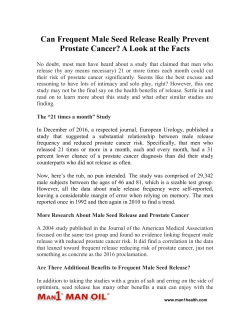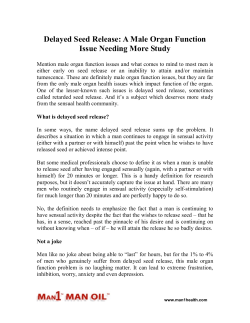
Male Organ Problems - Hey, There’s Blood in My Male Seed
Male Organ Problems: Hey, There’s Blood in My Male Seed Male organ problems can vary in severity and significance, as well as in what parts of the body they affect. For example, sometime they may impact the member itself, other times body parts that lead to the manhood in some way, and in yet others in components that are associated with the member – such as male seed. When there is blood in the male seed, this becomes a male organ health problem. But what causes it? And is it generally a serious problem? Blood in the male seed Although a man can get blood in the male seed any time after he has started producing male seed, it is more common among men between 30 and 40 and in men over 50. When blood is present, the color of the male seed tends to change from a milky or pale white to pink, reddish, or brownish. There can be several causes of blood in the male seed. The reason blood in the male seed becomes more common in men over 50 is that these men begin being checked for prostate issues – and one of the reasons why blood may suddenly appear in the male seed can be a complication from a biopsy of the prostate. It can also be due to other urogenital procedures, such as a vasectomy (which of course can occur in men of any age). During such procedures, a rupture occurs, which causes blood to flow and get mixed in with male seed elsewhere in the body. Similarly, prostate cancer may create this problem – but this tends to be fairly rare. However, this can be a warning sign of the cancer, so if there is no other likely cause, a doctor should check to see if prostate cancer is possible. More common A more likely reason for blood in the male seed is that a man has been working his manhood too vigorously during sensual activity, either with a partner or by himself. When the sensual activity gets a bit uninhibited or www.man1health.com rough, it may cause small ruptures in the male organ blood vessels, releasing blood. Also much more common, unfortunately, is the possibility that the bloody male seed is the result of a social disease. Several social diseases list blood in the male seed as symptoms – but so do some infections that are not necessarily passed on through sensual contact. Sometimes there may be blockage somewhere in the various tubes and ducts involved in male seed creation and transportation. When this happens, there may be rupture and the presence of blood. What to do If a man notices he has blood in his male seed, he should contact his doctor, especially if there is any pain in his manhood, if blood also shows up in the urine, or if he develops problems urinating. In many cases, the blood will go away without any treatment within a few days. How a doctor treats blood in the male seed will be based on his diagnosis of the cause. For example, a bacterial infection may require antibiotics. Finding blood in one’s male seed can cause anxiety, but often it is one of the less-serious male organ problems. Decreasing potential problems is a goal of good manhood care, which requires the regular use of a first-rate male organ health oil (health professionals recommend Man 1 Man Oil, which is clinically proven mild and safe for skin). There are a variety of creams and oils out there, but search for an oil that contains vitamin A, which is valued not only for its anti-aging and blemish-fighting properties but also for its ability to fight bacteria that can cause persistent member odor. Check also to see if the oil contains alpha lipoic acid, a potent antioxidant that can help fight free radicals and diminish oxidative stress. www.man1health.com
© Copyright 2025












